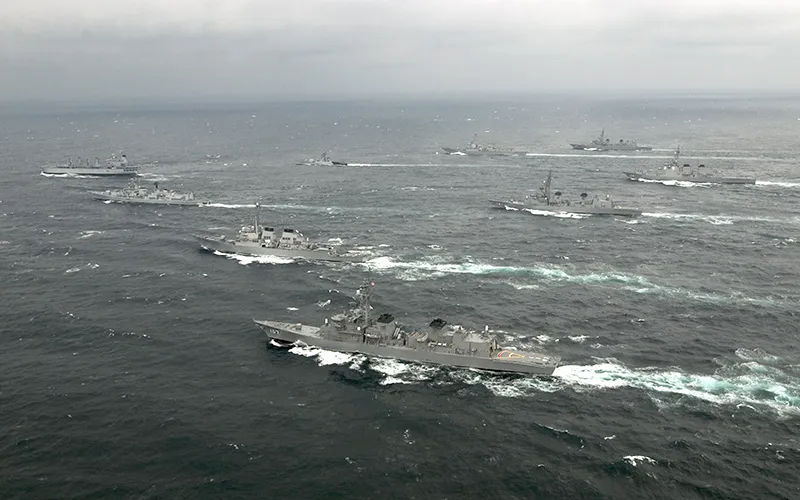"The Indian Navy and Australian Royal Navy are set to hold their first bilateral naval exercise (AUSINDEX) this month off the Visakhapatnam Port in the Bay of Bengal. This is a sign of growing security and defence cooperation between India and Australia. The exercise will focus on anti-submarine warfare and will feature coordinated anti-submarine military exercises. Reports indicate the participation of Lockheed Martin’s P-3 anti-submarine reconnaissance aircraft, a Collins-class submarine, a tanker and frigates from the Australian side whereas India will deploy a range of assets including Boeing’s P-8 long-range anti-submarine aircraft and a locally-manufactured corvette.
There are several different issues that complement the foreign policy thinking in New Delhi and Canberra. While China is clearly becoming a factor in the growing India-Australia defence ties, it will be erroneous to suggest that Beijing is the sole factor. The two also share some common vision about regional and global security, and their commitment to democracy, rule of law and human rights, have also been pertinent factors. Recognising this increasing synergy across political and strategic spheres, India and Australia signed in November 2014 the security cooperation framework agreement. Regular bilateral maritime exercises, along with periodic defence chiefs consultations are some of the security-related activities envisaged in this new framework agreement. Also the geographical location of both India and Australia makes the Indian Ocean a critical component of their security outlook. Maritime security and protection of sea lanes of communication (SLOCs) also add to the basket of issues that bring the two together.
The rise of China and its aggressive posturing has been a matter of concern to both India and Australia. The uncertainty as China grows stronger in the military arena has been highlighted in Australian defence white papers and official statements. The growing presence of China in the Indian Ocean has clearly served as a wake-up call for India and Australia. Sending two submarines on port visits to Sri Lanka’s commercial port in Colombo last year has made the Indian fears more real. The PLA Navy also frequents other ports in the Indian Ocean littoral including the Karachi port. Even as China does not have a permanent naval base in any foreign soil, it has raised its stake and influence in Indian Ocean by becoming pro-active in non-conventional maritime functions such as anti-piracy and SLOC protection patrols1. All of this suggests a new strategic competition brewing and increasing power tussle between China and other powers including India, US, Japan, and Australia. The relative decline of the US, which gained particular traction under the Obama Administration, has added fuel to the emerging security dynamics in the region.
India-Australia bilateral relations have been picking up for close to a decade now. In 2009, the two countries elevated their relationship to a strategic partnership, following which the defence ties have been growing with periodic consultations across a range of broad security and strategic issues. The bilateral dialogue and conversations have included nuclear non-proliferation and energy security, both in coal and civil nuclear, but is likely to expand to include solar and wind2. While the congruence of interests and ideas is indeed growing there are still hitches in the relationship, which both sides should take care to address.
India-Australia relations should not be approached through a strict bilateral perspective. Australia must be situated in the larger Asian strategic context and the role of Canberra in stabilizing the Indo-Pacific must not be lost. The fact that India and Australia have similar perspectives on regional security is a big push factor. This common understanding and vision on Asian stability should become the foremost consideration in the expanding bilateral security relations. The joint naval exercises are a right step in that direction. India and Australia need to nurture multiple regional platforms such as Indian Ocean Naval Symposium (IONS) to take forward the dialogue on Indian Ocean and maritime security.
(Dr. Rajeswari Pillai Rajagopalan is a Senior Fellow at Observer Research Foundation, Delhi)
1. There are reports that China may be establishing its foreign naval base in Djibouti. See Gabriel B. Collins and Andrew S. Erickson, ""Djibouti Likely to Become China’s First Indian Ocean Outpost,"" China SignPost 91, 11 July 2015, http://www.andrewerickson.com/2015/07/china-signpost-91-djibouti-likely-to-become-chinas-first-indian-ocean-outpost/.
2. Civil nuclear cooperation including Australian sale of uranium to India appears to be hitting another road block with Australia’s Treaties Committee recommending that Canberra cannot sell uranium to India unless India establishes an independent nuclear regulator. The fact that India is not a signatory to NPT and CTBT has also been cited as issues. For details, see Natasha Chaku, ""Australian Committee Puts Tough Condition on Uranium Sale to India,"" Outlook, September 8, 2015, http://www.outlookindia.com/news/article/australian-committee-puts-tough-condition-on-uranium-sale-to-india/912101. "
The views expressed above belong to the author(s). ORF research and analyses now available on Telegram! Click here to access our curated content — blogs, longforms and interviews.




 PREV
PREV


